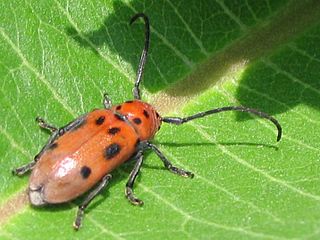Related Research Articles

The red milkweed beetle is a beetle in the family Cerambycidae.

The grey-crowned palm-tanager or grey-crowned tanager is a Near Threatened species of bird in the family Phaenicophilidae, the Hispaniolan palm-tanagers. It is endemic to the Caribbean island of Hispaniola, in both the Dominican Republic and Haiti.

Harpagoxenus is a genus of ants in the subfamily Myrmicinae. Found in the Palaearctic and Nearctic ecozones of the world, Harpagoxenus was first established as Tomognathus by Mayr (1861) to house the species Myrmica sublaevis. However, the name had already been used (homonym) for a genus of fish, and was replaced with its current name by Forel (1893).

Harpagoxenus sublaevis is a species of ant in the subfamily Myrmicinae. It is found in Austria, France, Germany, Italy, and Switzerland.
Canthocamptus sublaevis is a species of harpacticoid copepod in the family Canthocamptidae. It is found in Australia.

Tetraopini is a tribe of longhorn beetles in the subfamily Lamiinae.

Tetraopes is a genus of longhorn beetles of the subfamily Lamiinae, tribe Tetraopini, containing the following species:
Tetraopes annulatus is a species of beetle in the family Cerambycidae. It was described by John Lawrence LeConte in 1847. It is known from the United States and Canada. Reported feeding on Asclepias sullivantii, A. subverticillata, A. speciosa, A. tuberosa, A. verticillata, A. viridiflorus.

Tetraopes femoratus is a species of beetle in the family Cerambycidae. It was described by John Lawrence LeConte in 1847. It is known from Mexico and the United States.
Tetraopes umbonatus is a species of beetle in the family Cerambycidae. It was described by John Lawrence LeConte in 1852. It is known from Nicaragua and Mexico.
Tetraopes batesi is a species of beetle in the family Cerambycidae. It was described by Chemsak in 1963. It is known from Mexico.
Tetraopes linsleyi is a species of beetle in the family Cerambycidae. It was described by Chemsak in 1963. It is known from the United States.
Tetraopes mandibularis is a species of beetle in the family Cerambycidae. It was described by Chemsak in 1963. It is known from the United States.
Tetraopes cleroides is a species of beetle in the family Cerambycidae. It was described by James Thomson in 1860. It is known from Mexico.
Tetraopes ineditus is a species of beetle in the family Cerambycidae. It was described by Chemsak and Giesbert in 1986. It is known from Mexico.
Tetraopes quinquemaculatus is a species of beetle in the family Cerambycidae. It was described by Haldeman in 1847. It is known from North America.
Tetraopes submersus is an extinct species of beetle in the family Cerambycidae. It was described by Theodore Dru Alison Cockerell in 1908. It existed in what is now the United States.
Tetraopes termophilus is a species of beetle in the family Cerambycidae. It was described by Chevrolat in 1861. It is known from Nicaragua and the United States.
Tetraopes thermophilus is a species of flat-faced longhorn in the beetle family Cerambycidae. It is found in Central America and North America.
Lytta sublaevis is a species of blister beetle in the family Meloidae. It is found in North America.
References
- ↑ BioLib.cz - Tetraopes sublaevis. Retrieved on 8 September 2014.